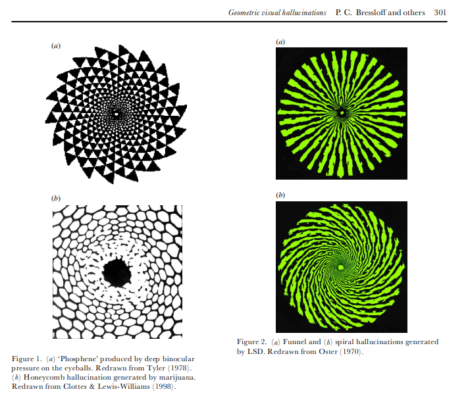
Do you ever wonder why people have such intense hallucinogenic experiences when they take psychedelics? For centuries, the question of how psychoactive substances influence our minds has captivated mankind and continues to elude even modern scientific pursuits. Brain-imaging technology may have advanced significantly over time, yet this perplexing query still stumps scientists, researchers, amateur chemists and psychonauts alike.
In August 2000, a paper published in the journal of the Royal Society titled Geometric visual hallucinations, Euclidean symmetry and the functional architecture of striate cortex, explored why we often witness such remarkable visions when taking psychedelics. A closer examination of this phenomenon revealed “striking” geometric visual hallucinations that were truly captivating.
Our understanding of the geometric visual hallucinations we experience while on a psychedelic journey is rooted in both mathematics and neurology, psychology, and cognitive sciences. This study, as well as contributions from mathematicians at universities around Utah, Chicago and Houston plus researchers from the Salk Institute for Biological Studies and NIH reveals that geometry may be the key to unlocking answers surrounding these mysterious hallucinations.
Let’s take a closer look at the study in question…
The researchers used math and shape theory to make a convincing argument that the part of our retinal visual cortex and associated neuronal circuitry are what causes our psychedelic visuals. They proposed that the “patterns of connections” between these elements may be responsible for classic hallucinations following ingesting psychedelics. Even though this is hard to explain, they found something interesting which could be explored further.
The striate cortex is a pivotal area of the brain responsible for deciphering visual information. It houses cells particularly attuned to various elements such as lines, edges, and orientations that are organized in an orderly fashion, so neighboring cells respond similarly to these features. This structure not only makes it simpler for the brain to process what we see but also enables it do its job with impressive efficiency.
Geometric visual hallucinations are a type of hallucination characterized by the perception of complex geometric shapes and patterns. These hallucinations often involve Euclidean symmetry, which is a type of symmetry associated with geometric shapes and patterns that are symmetrical in a way that is consistent with the principles of Euclidean geometry.

According to this research, the structural organization of the striate cortex could be responsible for producing geometric visual hallucinations. As per the authors’ hypothesis, when activity within this area is disrupted – such as through psychedelic use – cells that favor particular visual features (e.g., those related to Euclidean symmetry) become activated and lead to a person perceiving these types of illusions.
This idea is supported by research that has shown that psychedelic drugs, such as LSD and psilocybin, can induce geometric visual hallucinations that are similar to those observed in conditions such as Charles Bonnet syndrome and migraine aura. These hallucinations often involve complex geometric shapes and patterns, as well as a high degree of symmetry. This is consistent with the idea that the functional organization of the striate cortex may be responsible for generating these hallucinations.
Overall, the study offers an enlightening look at how the functioning of the striate cortex relates to geometric visual halluinations and Euclidean symmetry. While we don’t yet know exactly what causes this relationship, this framework can help us understand why psychedelic drugs or certain mental states evoke these kinds of experiences – ultimately prompting further exploration into their etiology.
It may be a mystery as to why some of us experience geometric visuals when we’re out-of-body tripping on psychedelics, but the evidence does suggest that our visual perceptions are influenced by the functional structure of our striate cortex. Neuroscientists have found that the brain has an inherent preference for underlining patterns and geometrical shapes which can result in familiar forms that our conscious mind instinctively recognizes. Combining these scientific data points with anecdotal reports from those who have experienced psychedelic substances could potentially lead to further understanding into why people see specific abstract visuals during hallucinogenic episodes. Regardless of what causes this phenomena, it is clear that psychedelic experiences offer striking new insights into the science of vision as well as its relationship to consciousness.
You may also like: Encountering DMT Entities: Are They real?
- Ungerleider, L. G., & Mishkin, M. (1982). Two cortical visual systems. In D. J. Ingle, M. A. Goodale, & R. J. W. Mansfield (Eds.), Analysis of visual behavior (pp. 549-586). Cambridge, MA: MIT Press. (This classic paper proposes the dual-stream theory of visual processing, which suggests that the striate cortex and the ventral visual stream are specialized for different types of visual information.)
- Hubel, D. H., & Wiesel, T. N. (1968). Receptive fields and functional architecture of monkey striate cortex. The Journal of Physiology, 195(1), 215-243. doi: 10.1113/jphysiol.1968.sp008455 (This seminal study describes the discovery of orientation-selective cells in the striate cortex and their arrangement in a functional map.)
- Blanke, O., Landis, T., & Seeck, M. (2000). Electrical cortical stimulation of the human prefrontal cortex evokes complex visual hallucinations. Epilepsy & Behavior, 1(5), 356-361. doi: 10.1006/ebeh.2000.0108 (This study reports the induction of complex visual hallucinations by electrical stimulation of the prefrontal cortex, suggesting that hallucinations can result from disruption of higher-order cognitive processes.)
- Ffytche, D. H., & Howard, R. J. (1999). The perceptual consequences of visual loss: ‘positive’ pathologies of vision. Brain, 122(7), 1247-1260. doi: 10.1093/brain/122.7.1247 (This review article summarizes the different types of visual hallucinations that can occur in neurological disorders, including geometric patterns.)
- Williams, R. J., & Stanley, G. B. (2018). Dependence of visual cortical plasticity on layer IV cell-targeted inhibition. Neuron, 99(4), 814-828.e6. doi: 10.1016/j.neuron.2018.07.008 (This recent study shows that selective inhibition of layer IV cells in the striate cortex can enhance or suppress cortical plasticity, indicating a crucial role for inhibition in shaping visual processing.)





